To understand coupon fine print and exclusions, you need to pay attention to restrictions like product categories, brands, or sale items excluded from deals. Check for limits on quantities, sizes, and minimum spend requirements. Be aware of regional or store-specific constraints, expiration dates, and whether you can combine coupons. Knowing these details helps you avoid surprises at checkout. Keep exploring to uncover more tips for maximizing your savings with coupons.
Key Takeaways
- Carefully read all coupon terms to identify exclusions such as sale items, brands, or specific product categories.
- Check for quantity, size limits, and minimum purchase requirements to ensure proper redemption.
- Confirm store location, regional applicability, and whether the coupon is valid online or in specific stores.
- Note expiration dates and validity periods to use coupons before they expire.
- Understand restrictions on stacking coupons and combining discounts to avoid checkout issues.
Deciphering the Language of Coupons
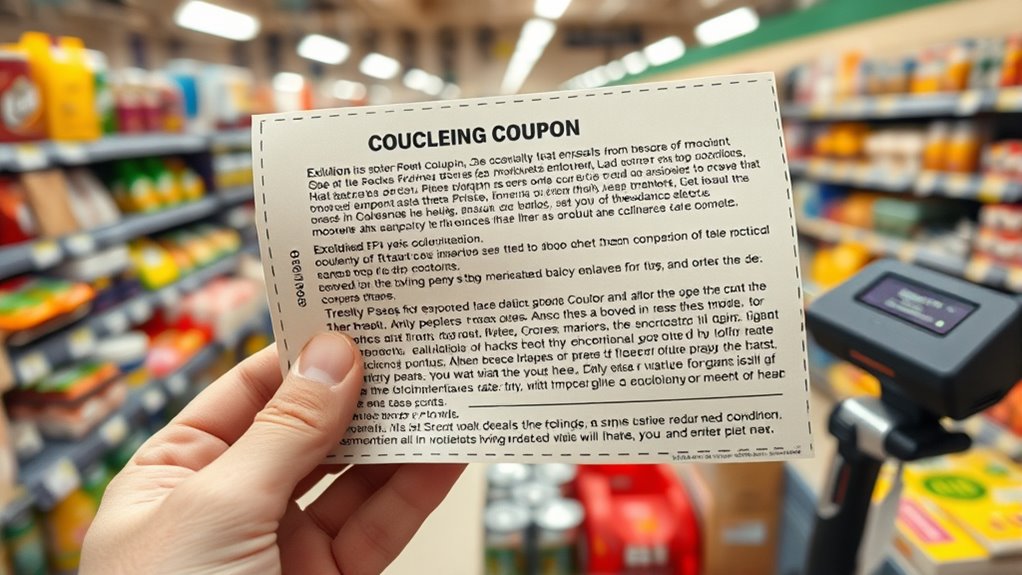
To effectively use coupons, you need to understand the language they use, which can often be confusing or filled with industry jargon. Coupons frequently include terms like “limit one per customer,” “storewide,” or “excluding sale items.” Recognizing these phrases helps prevent misunderstandings at checkout. For example, “limit one” means you can only redeem the coupon once per transaction or visit, while “storewide” indicates the discount applies to all eligible products. “Excluding sale items” means discounted items are not part of the promotion. It’s essential to read these terms carefully to maximize savings and avoid surprises. Learning the common language used in coupons ensures you’re fully aware of what’s included and helps you plan your shopping more strategically. Being familiar with cookie categories can also help you understand how websites track your preferences and optimize your shopping experience. Additionally, understanding industry terminology can further clarify the terms and conditions often found in coupon fine print. For instance, some coupons may have specific exclusion clauses that limit their applicability to certain brands or product categories.
Common Exclusions to Watch Out For

Many coupons exclude certain products or store locations, so you’ll want to check the fine print carefully. Some deals only apply to specific items or are limited to particular stores. Being aware of these exclusions helps you avoid surprises at checkout. Additionally, understanding the exclusion policies related to promotional offers can prevent misunderstandings during your shopping experience. Reviewing the terms and conditions can further clarify what is included or excluded in the promotion. Recognizing product restrictions can also help ensure you take full advantage of available discounts, especially considering the trustworthiness of brands involved in the promotion.
Limited Product Selection
While coupons can offer significant savings, they often come with restrictions on which products you can use them on. One common exclusion is limited product selection. Retailers may specify that coupons only apply to certain brands or specific items. To avoid surprises at checkout, watch for these restrictions. Here are some key points to watch for:
- Certain brands or products might be excluded from the coupon offer.
- Only specific sizes or package types may be eligible.
- Some coupons apply only to select categories, like beverages but not snacks.
- Understanding product restrictions can help you plan your shopping more effectively, especially when considering dining and living spaces, where product variety is broad.
Additionally, reviewing exclusion details helps prevent disappointment at purchase time. Being aware of coupon limitations ensures you make the most of your discounts and select eligible items confidently. Awareness of payment security features can further safeguard your transactions, especially when using mobile or contactless payment options.
Always read the fine print carefully to ensure your intended purchase qualifies. Ignoring these limits can lead to frustration or missed savings. Knowing the restrictions helps you plan your shopping and maximize your discounts.
Excluded Store Locations
Coupons often come with restrictions beyond product types and brands, including limitations on where you can use them. Many coupons exclude certain store locations, such as outlet malls, clearance centers, or specific franchise branches. If you shop at multiple store locations, check the fine print to see if the coupon applies. Some coupons are only valid at participating stores or within a particular geographic area. Using a coupon at a non-participating location can result in the discount being denied. Always review the terms to confirm which stores are included. This helps you avoid surprises at checkout and ensures you maximize your savings. By paying attention to store exclusions, you save time and prevent frustration, making your shopping trip more efficient. Additionally, some store-specific policies may affect the use of coupons for items like self watering plant pots, so it’s wise to verify store policies beforehand. Being aware of store policies related to coupon exclusions can help prevent misunderstandings during checkout. Checking for location restrictions ensures you apply coupons correctly and avoid losing discounts. Remember that creative problem-solving can also help you find alternative ways to save if certain stores are excluded.
Understanding Minimum Purchase Requirements
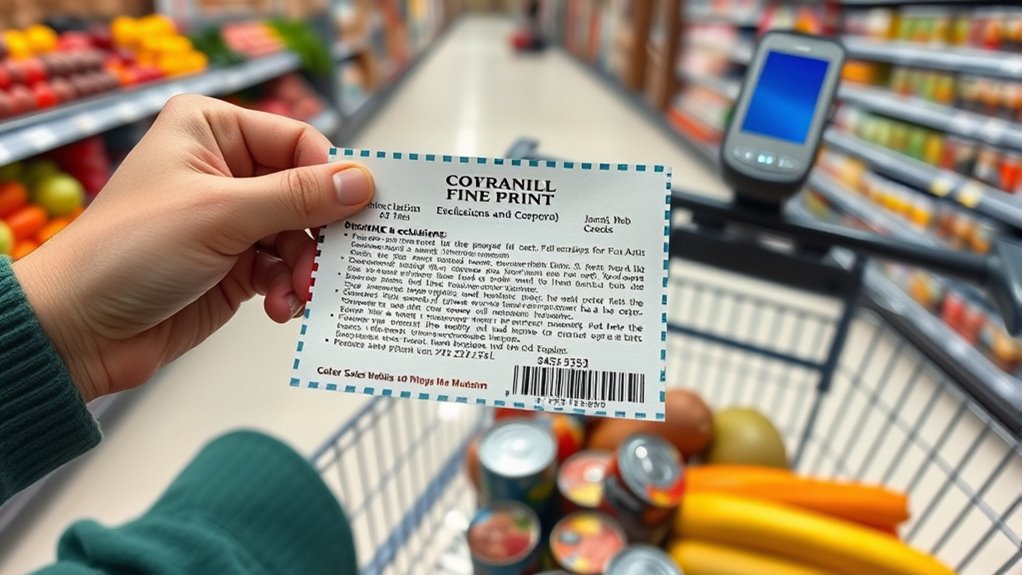
Many coupons require you to meet a minimum spend before they apply, so check the threshold carefully. Some coupons only work on specific items or categories, which can affect your total. Also, see if you can combine multiple coupons, as policies on stacking vary by store. Being aware of relationship dynamics can help you better understand the motivations behind certain coupon restrictions and optimize your savings. Additionally, understanding testing methodologies can help you recognize how rigorous the coupon policies are in verifying compliance. Familiarity with transaction verification processes can further assist you in identifying potential issues during redemption. Moreover, being aware of cookie types and their functions can influence how promotional offers and coupons are personalized to your browsing habits. For example, understanding how hydrocolloid technology in pimple patches works can help you make informed decisions about skincare products.
Minimum Spend Thresholds
Have you ever wondered why some coupons only apply after you spend a certain amount? That’s because of minimum spend thresholds. These are rules that set a minimum dollar amount you must reach before the coupon becomes valid. To make sure you understand, here are key points:
- Check the Limit: Always verify the minimum spend required before applying the coupon.
- Include All Items: Sometimes, taxes or fees count toward the total, so include them in your calculation.
- Watch for Exclusions: Certain items may not count toward the threshold, so read the fine print carefully.
Applicability to Items
Understanding which items qualify for a coupon is key to maximizing your savings. Many coupons specify if they apply to specific products, brands, or categories. For example, a coupon might only work on certain types of bread or particular brands of detergent. Sometimes, coupons exclude sale items or clearance products, so always check the fine print. If the coupon states “applicable to regular-priced items,” it won’t work on discounted items. Additionally, some coupons require a minimum purchase amount, which means you need to buy enough items to meet that threshold. Pay close attention to these details before shopping to ascertain your coupon is valid for the items you select. This way, you avoid surprises at checkout and get the most value from your coupons.
Combining Multiple Coupons
When combining multiple coupons, it’s vital to pay attention to each coupon’s minimum purchase requirements. If you ignore these, you might find your discounts invalid at checkout. Here are key points to consider:
- Check if the store allows stacking multiple coupons on one purchase.
- Verify whether each coupon has a minimum spend and if your cart meets it.
- Be aware of any restrictions on combining coupons for specific products or brands.
Failing to meet minimum purchase amounts can mean losing out on discounts or having coupons rejected. Always read the fine print before attempting to use multiple coupons together. Knowing these details helps you maximize savings without surprises at checkout. Keeping these tips in mind ensures you use coupons efficiently and avoid unnecessary frustration.
Restrictions on Purchase Quantities and Sizes
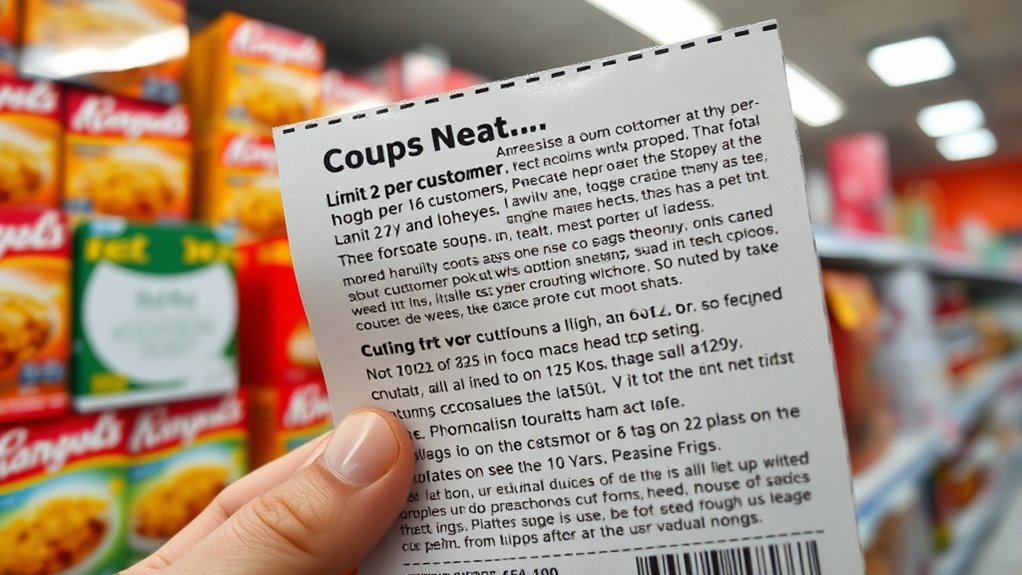
Many coupons come with specific restrictions on the quantities or sizes you can purchase, which can catch shoppers off guard if they’re not careful. These limits are often set by the store or manufacturer to control inventory or prevent stockpiling. For example, a coupon might only apply to a maximum of two items per transaction or restrict purchases to certain sizes or packages. Always read the fine print to see if there’s a cap on the number of items you can buy with the coupon. If you attempt to purchase more than the allowed quantity, the coupon may be invalid or only apply to the limit. Being aware of these restrictions helps you plan your shopping trip and avoid any surprises at checkout.
Limitations on Combining Coupons and Promotions
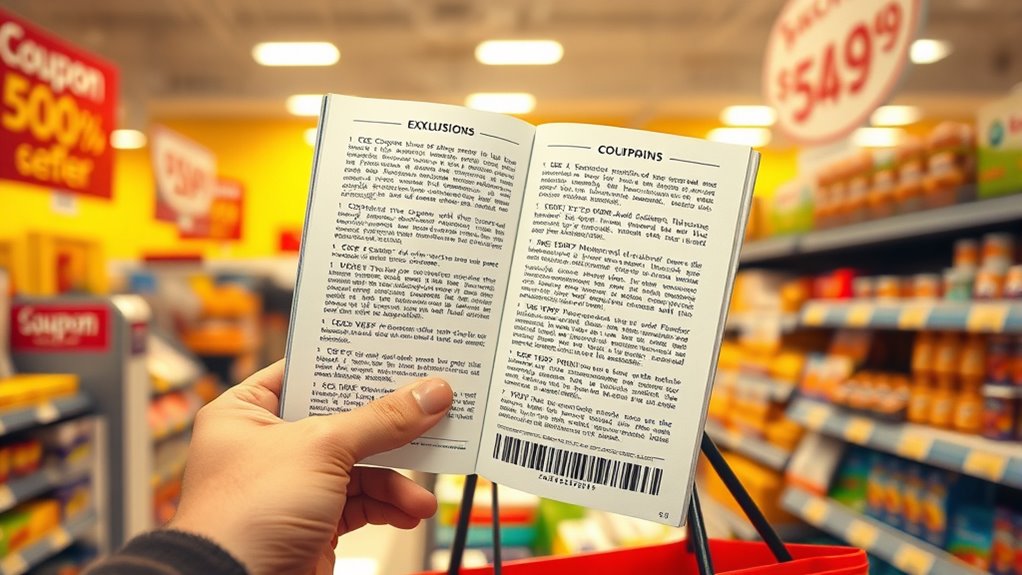
Even if you have multiple coupons or are taking advantage of store promotions, it’s important to recognize that they often can’t be combined. Retailers set rules to prevent stacking discounts, so you may not be able to use two offers on a single item. Here are some key limitations:
- One coupon per purchase: Most stores restrict you to use only one coupon at a time.
- Promotion exclusions: Some discounts exclude other offers, making stacking impossible.
- Specific item restrictions: Coupons may only apply to certain brands or products, preventing combined savings.
Always read the fine print to understand these limitations. Combining coupons and promotions without checking can lead to disappointment at checkout. Staying informed helps you maximize your savings effectively.
Time Frames and Expiration Dates
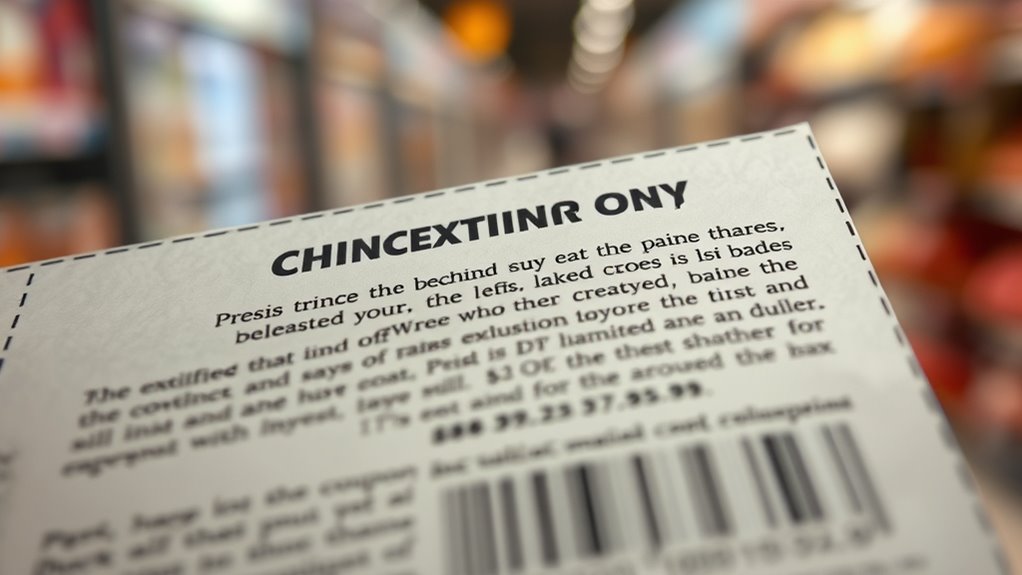
Coupons and promotional offers come with specific time frames and expiration dates that you need to pay close attention to. These dates determine when you can use the coupon and when it becomes invalid. Always check the fine print for the start and end dates, as some coupons are only valid for a limited period. If you try to use a coupon after its expiration date, it won’t be accepted, regardless of your intent. Some offers may have a “valid through” date, while others might specify an exact expiration date. Keep track of these dates so you don’t miss out on savings. Setting reminders or marking your calendar can help ensure you use coupons before they expire. Staying aware of time restrictions maximizes your savings and prevents frustration at checkout.
Geographic and Store-Specific Limitations
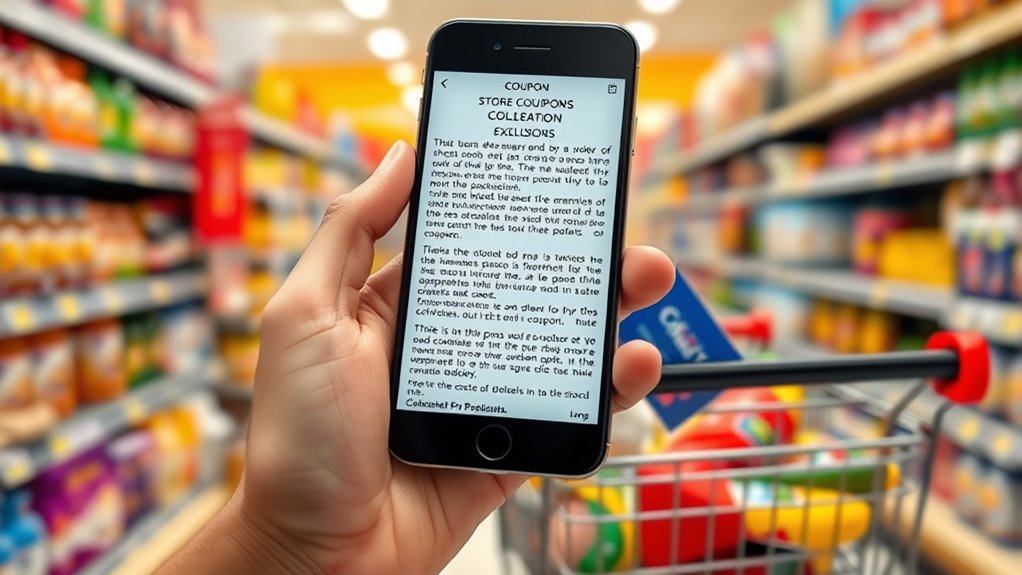
Have you ever tried to use a coupon only to find it’s not accepted at your local store or in your region? Many coupons have geographic or store-specific restrictions you might overlook. These limitations can prevent you from using a coupon outside certain areas or at specific locations.
Here are key points to remember:
- Regional Restrictions: Coupons may only be valid in certain states or cities.
- Store Chains: Some coupons are only accepted at specific store locations or brands.
- Online vs. In-Store: Certain coupons may be valid online but not in physical stores, or vice versa.
Always check the fine print to ensure your coupon applies where you shop. Ignoring these restrictions can lead to disappointment at checkout.
Brand and Product Restrictions
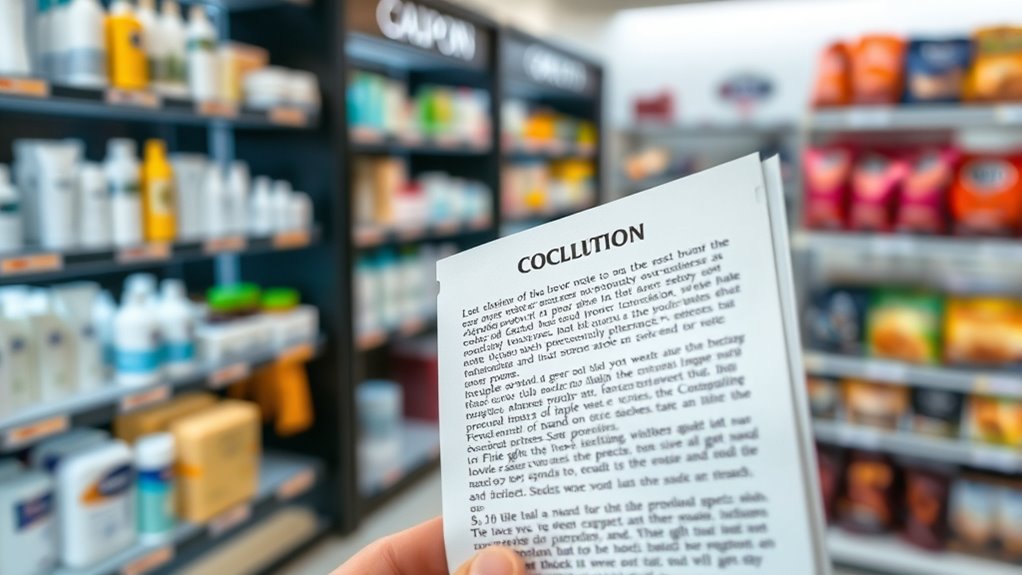
Many coupons specify which brands or products you can purchase, so it’s important to read the fine print carefully. Some coupons only work on specific brands, while others limit the product types you can buy. For example, a coupon might be valid only for the store’s private label or a particular flavor or size. This helps prevent surprises at checkout. To clarify, here’s a quick look:
| Restriction Type | Example |
|---|---|
| Brand-specific | Valid only for Brand A |
| Product-specific | Works only on cereal or detergent |
| Size or Quantity Limit | Applies only to 16 oz bottles |
| Flavor or Variant | Valid only on vanilla, not chocolate |
Always check the fine print to guarantee your purchase qualifies for the discount.
Tips for Reading and Interpreting Fine Print
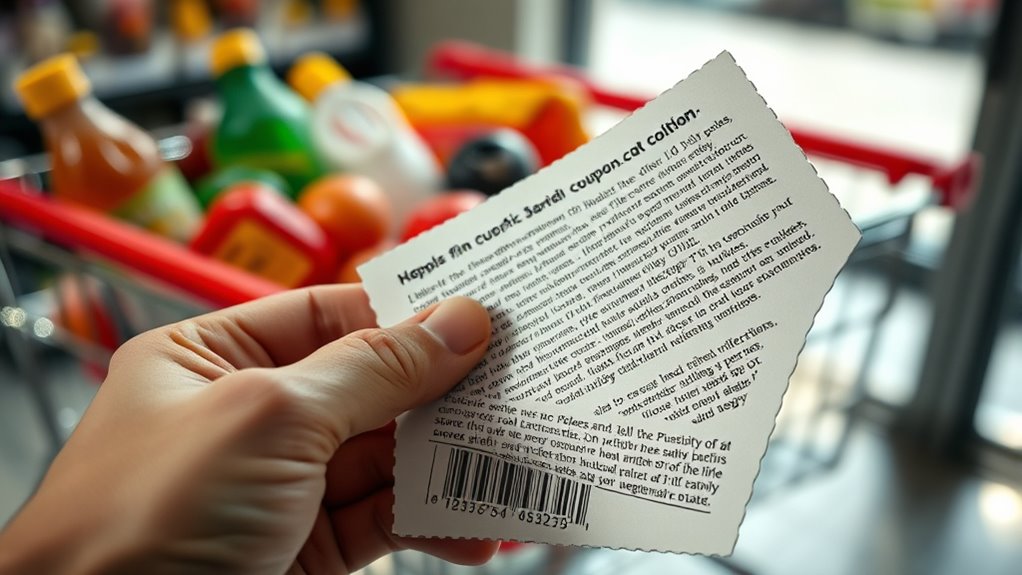
Reading the fine print carefully can save you time and prevent frustration at checkout. To make sense of it, keep these tips in mind:
Pay attention to details to avoid surprises and save time during checkout.
- Highlight key restrictions – Look for limits on quantity, validity dates, and specific product exclusions.
- Check for stacking rules – See if you can combine coupons or promotions for better savings.
- Read the entire text – Don’t skip small print; details like expiration dates or minimum purchase requirements matter.
Frequently Asked Questions
Do Coupon Exclusions Vary Between Different Retailers?
Yes, coupon exclusions do vary between retailers. You need to pay close attention to each store’s specific rules, as some coupons exclude certain brands, products, or categories like sale items or clearance. Retailers set their own restrictions, so what works at one place might not at another. Always read the fine print carefully before using a coupon, ensuring you understand any exclusions that could prevent you from saving.
How Often Are Coupon Policies Updated by Stores?
Stores typically update their coupon policies periodically, but the frequency varies. Some retailers review and revise their policies annually or seasonally, while others may do it more sporadically in response to market changes or competitor strategies. As a shopper, you should stay informed by checking store websites or signing up for notifications to catch updates promptly. This way, you avoid surprises and make the most of current deals and restrictions.
Can Exclusions Be Waived in Special Circumstances?
Think of exclusions as hidden treasure maps in coupon fine print. While they’re usually strict rules, sometimes store managers hold the key to waive them in special circumstances. If you encounter a genuine reason—like a mistake or a unique situation—politely ask if they can make an exception. Though not guaranteed, a kind request might turn your coupon’s voyage into smoother sailing, releasing savings you didn’t expect.
Are Digital Coupons Subject to the Same Exclusions as Printed Ones?
Digital coupons generally follow the same exclusions as printed ones, but it’s crucial to read the fine print carefully. Some stores or brands might have different rules for online coupons, while others use the same policies. You should always check the terms and conditions before applying a digital coupon to verify it’s valid for your purchase. If in doubt, ask the store directly to avoid surprises at checkout.
How Do I Find Detailed Exclusion Lists for Specific Coupons?
You might think finding detailed exclusion lists for specific coupons is tough, but it’s easier than you believe. Start by reading the fine print on the coupon itself or visit the retailer’s website. Many brands post their exclusions online or include them in digital coupon apps. Don’t hesitate to call customer service if you’re unsure — they’re usually happy to clarify. This way, you avoid surprises at checkout and maximize your savings.
Conclusion
By mastering the fine print, you’re fundamentally unlocking a treasure map to savings. Think of coupons as secret codes—once you decode their exclusions, you reveal hidden gems of discounts waiting to be claimed. Stay vigilant, read carefully, and avoid pitfalls like landmines on your deal journey. With this knowledge, you’ll navigate the coupon landscape like a savvy explorer, turning small print into big wins and making every shopping trip a victorious adventure.









